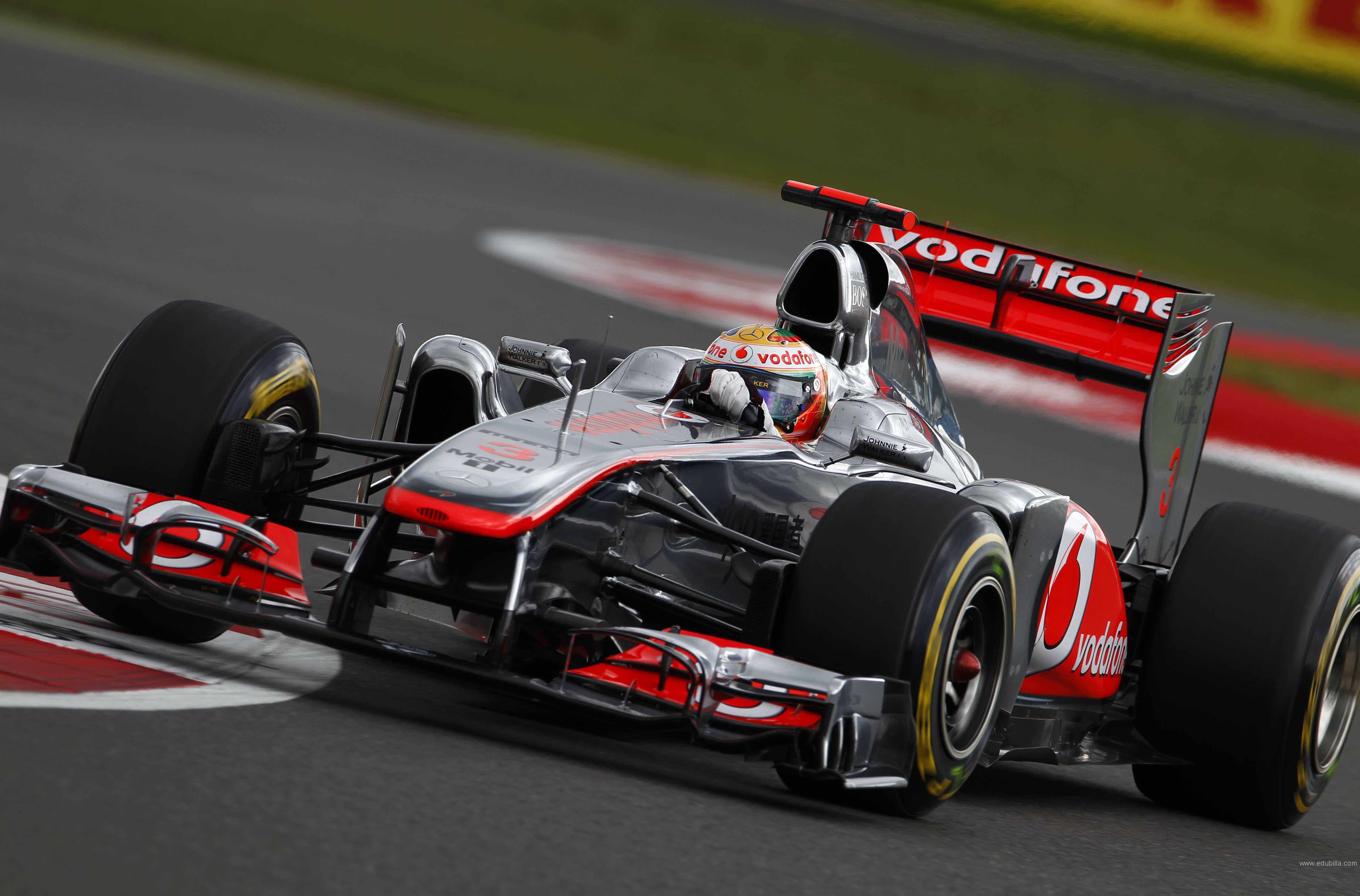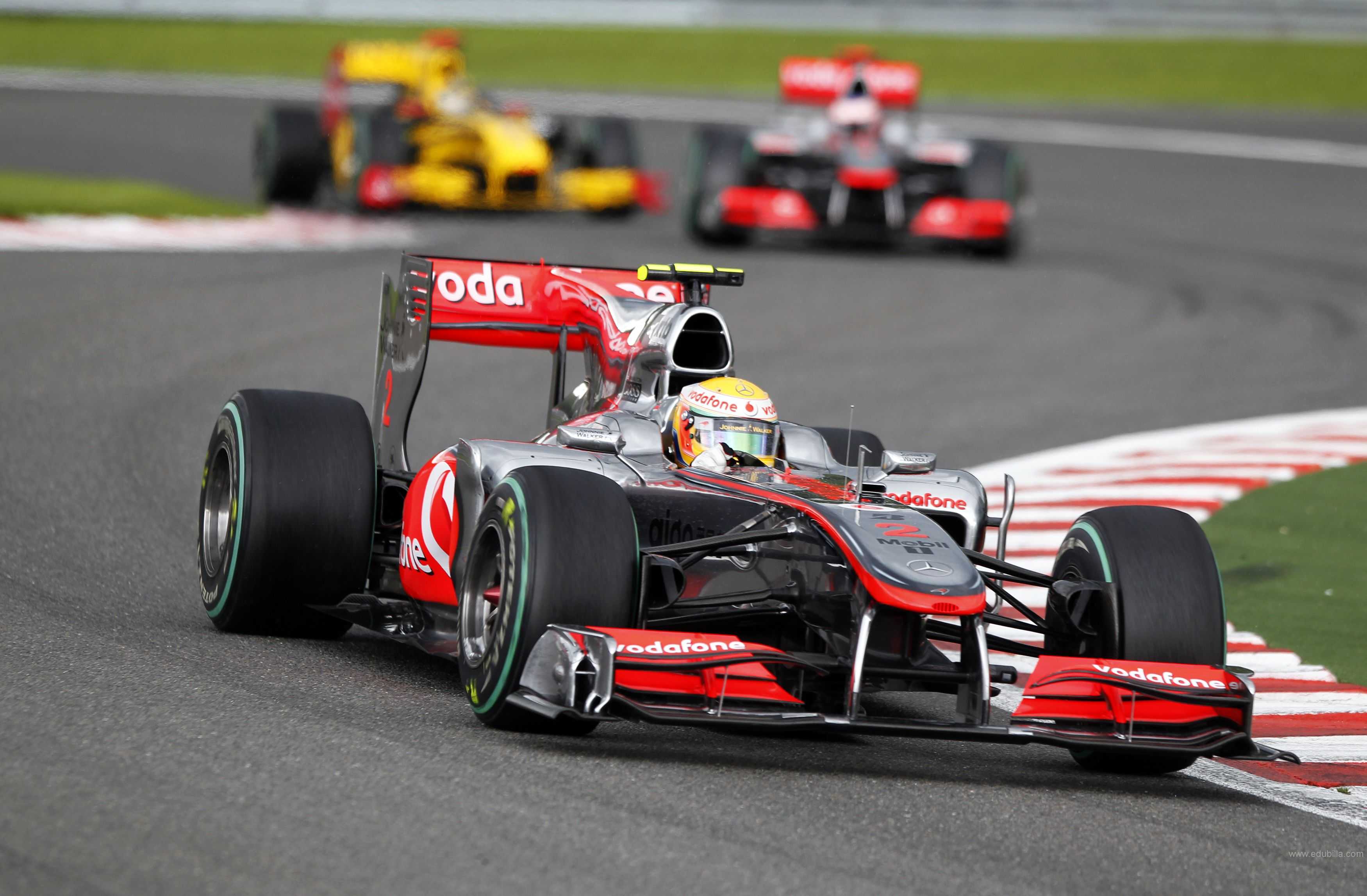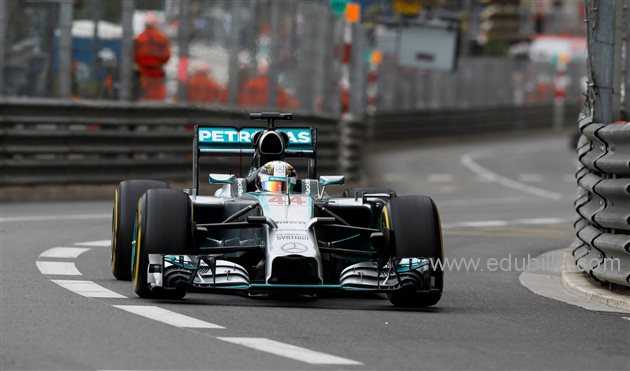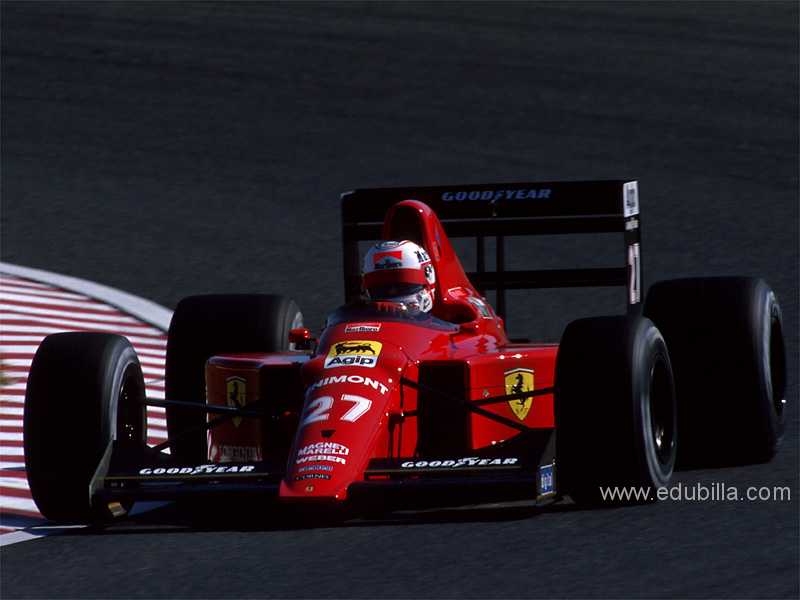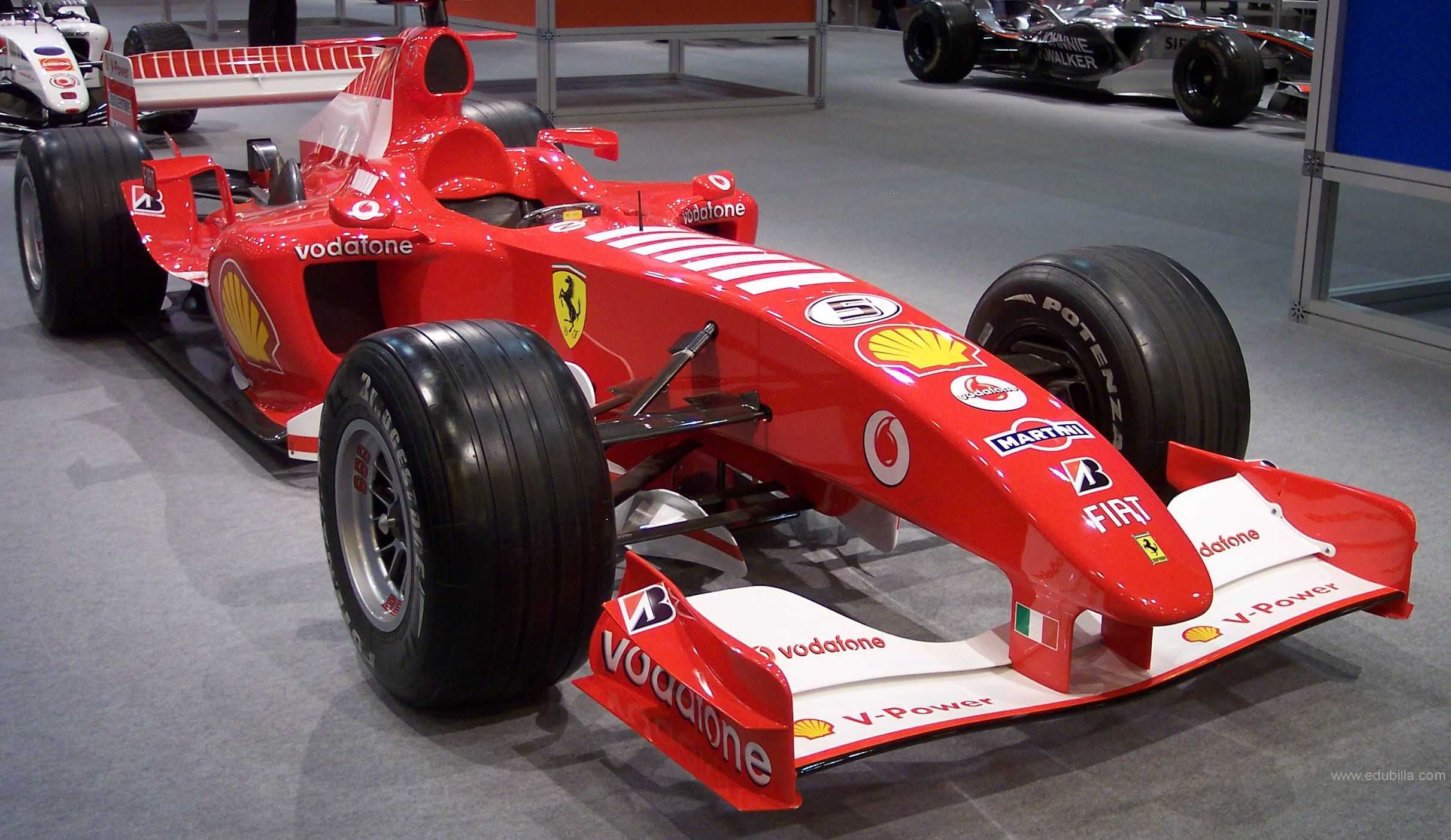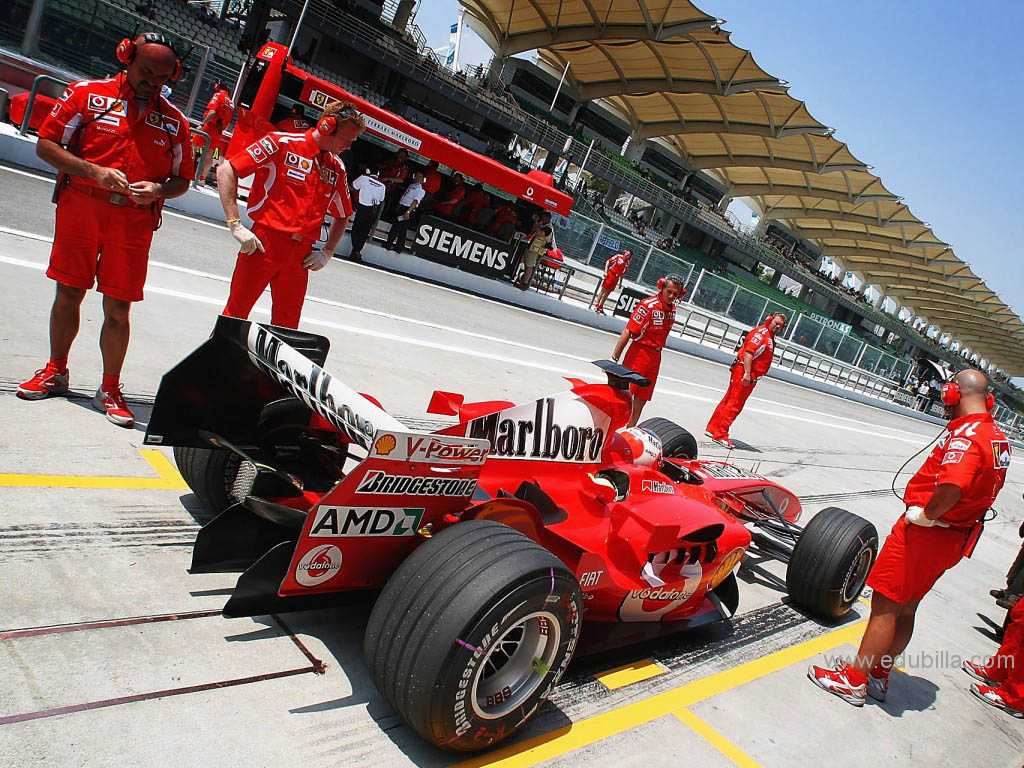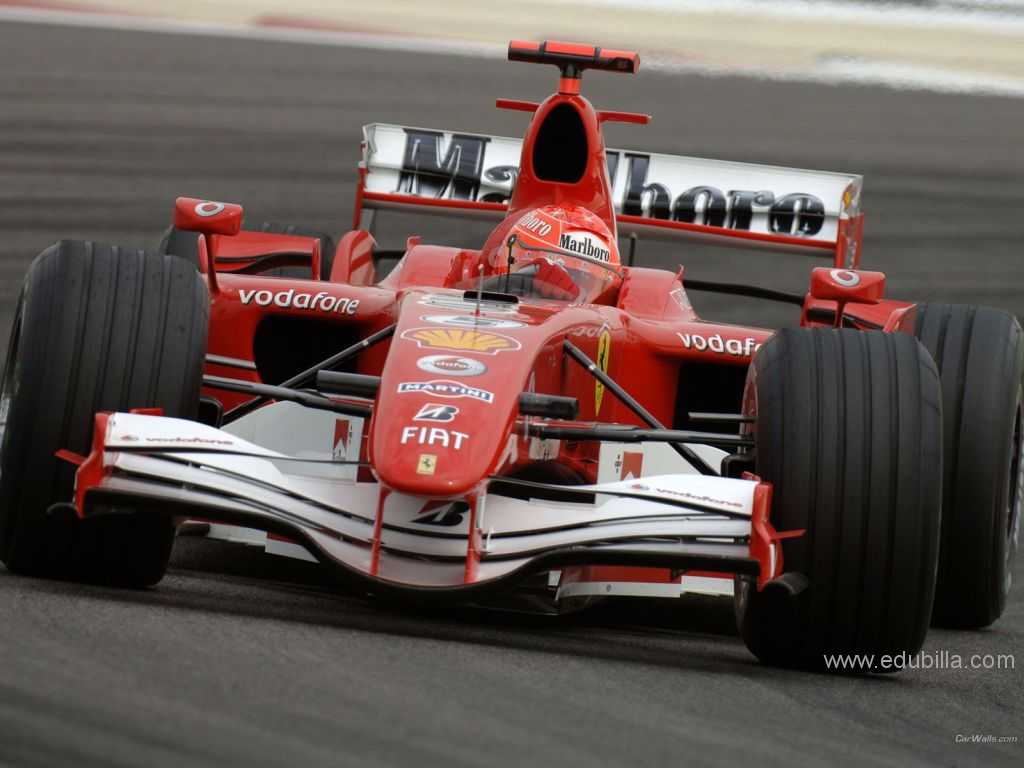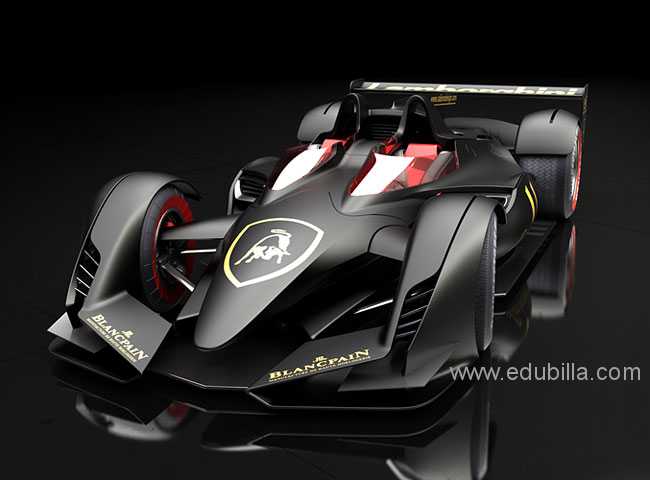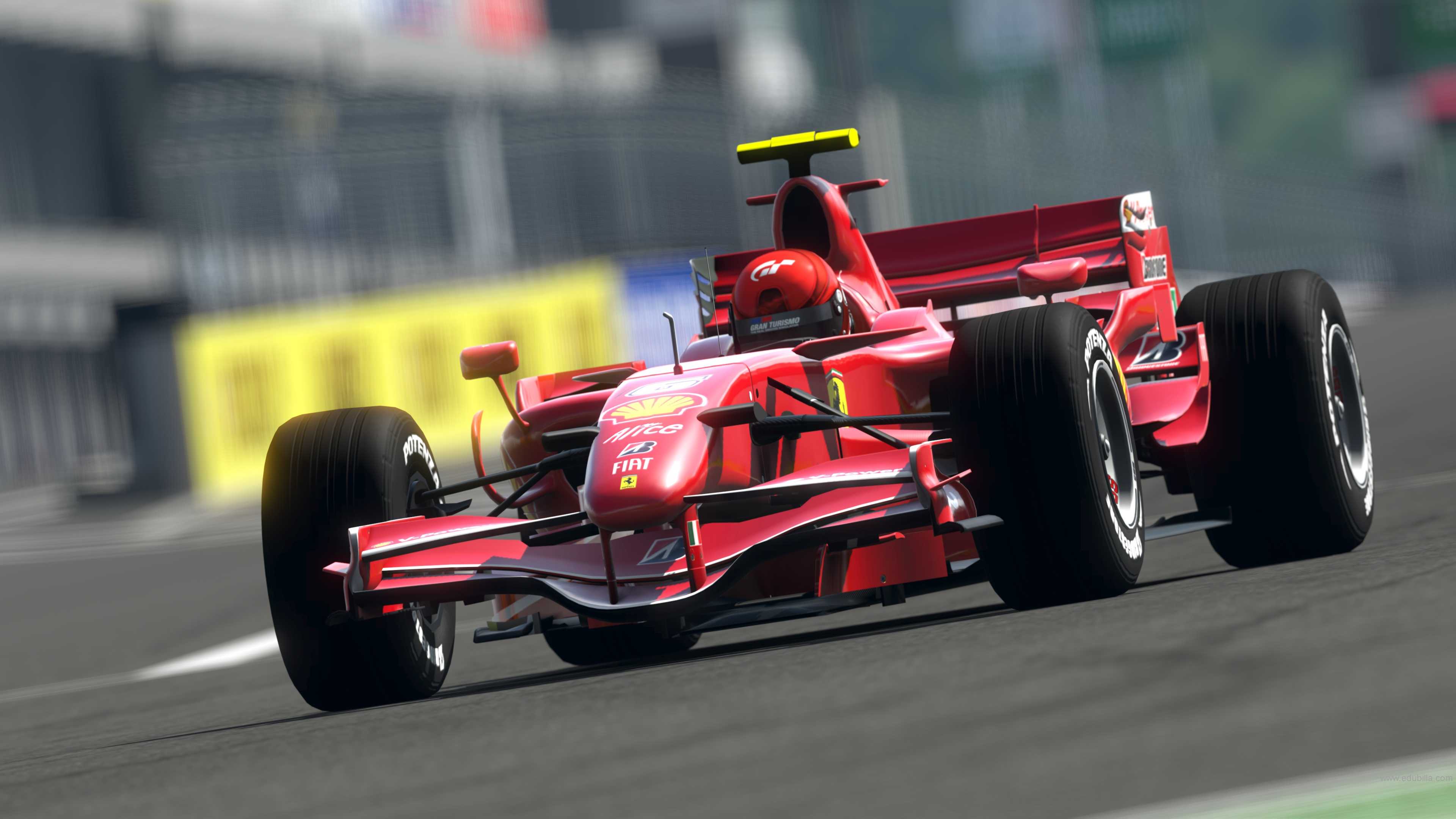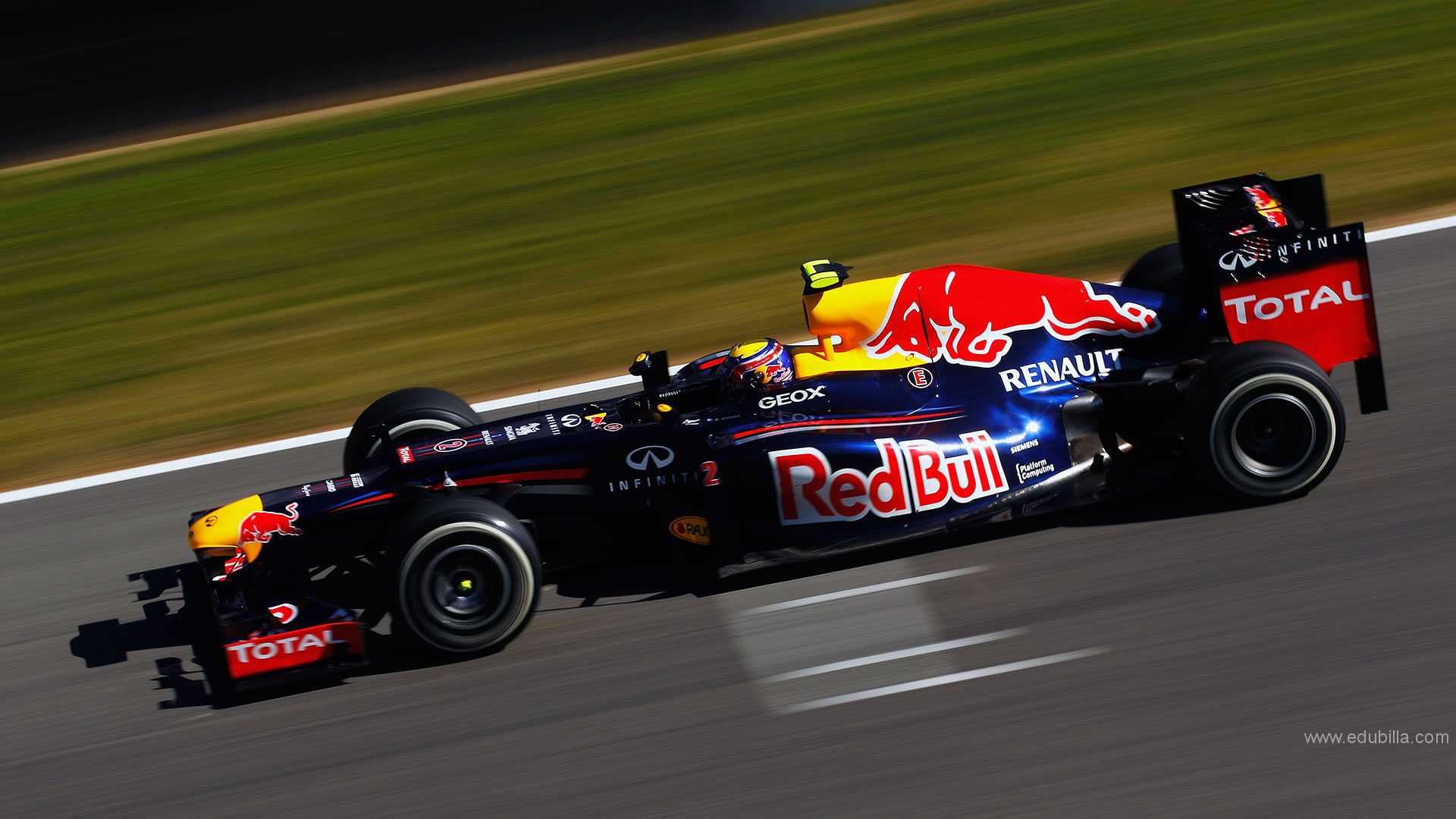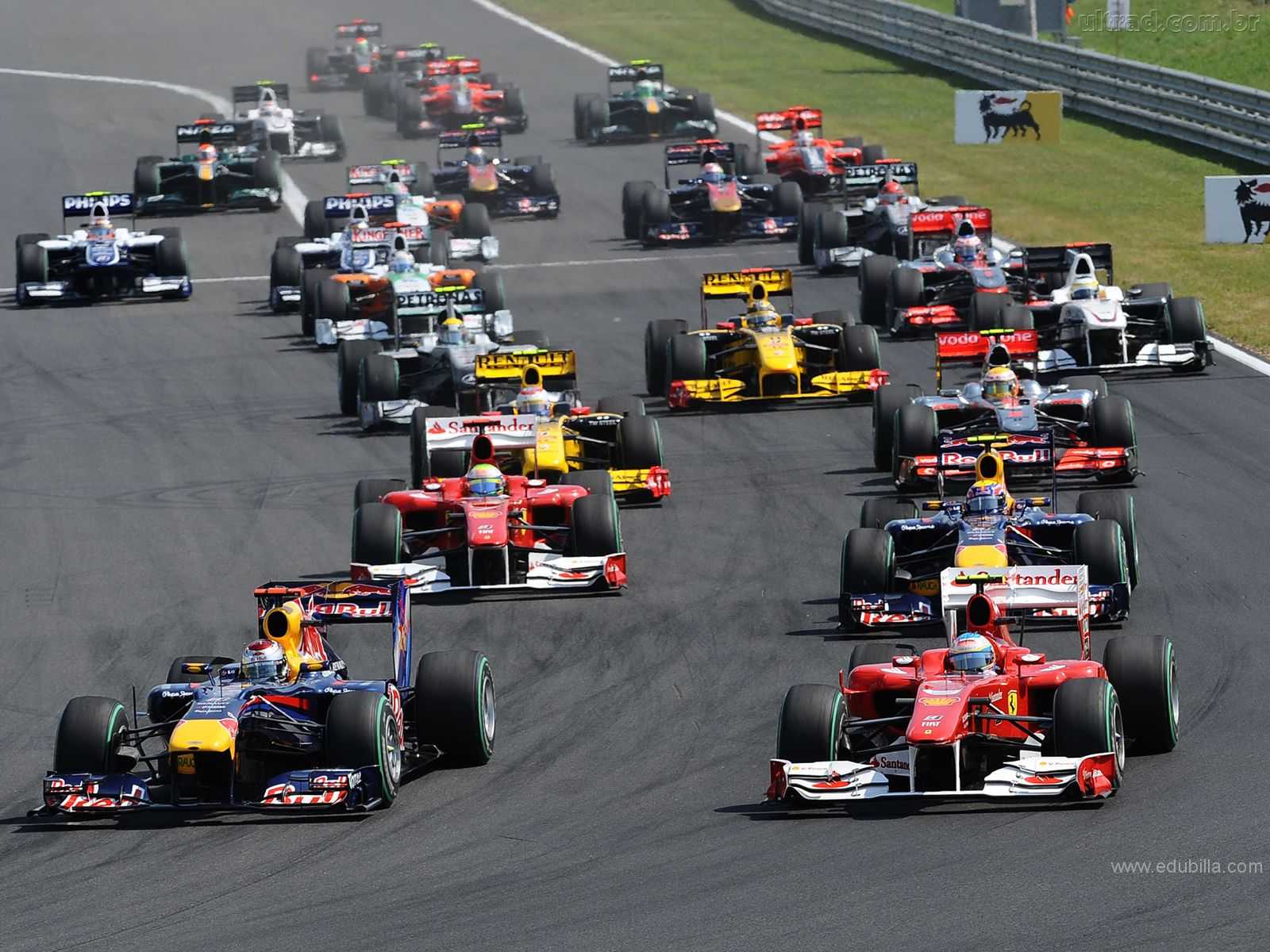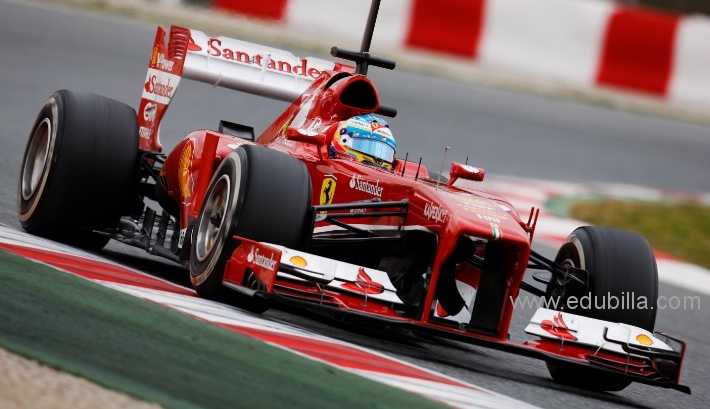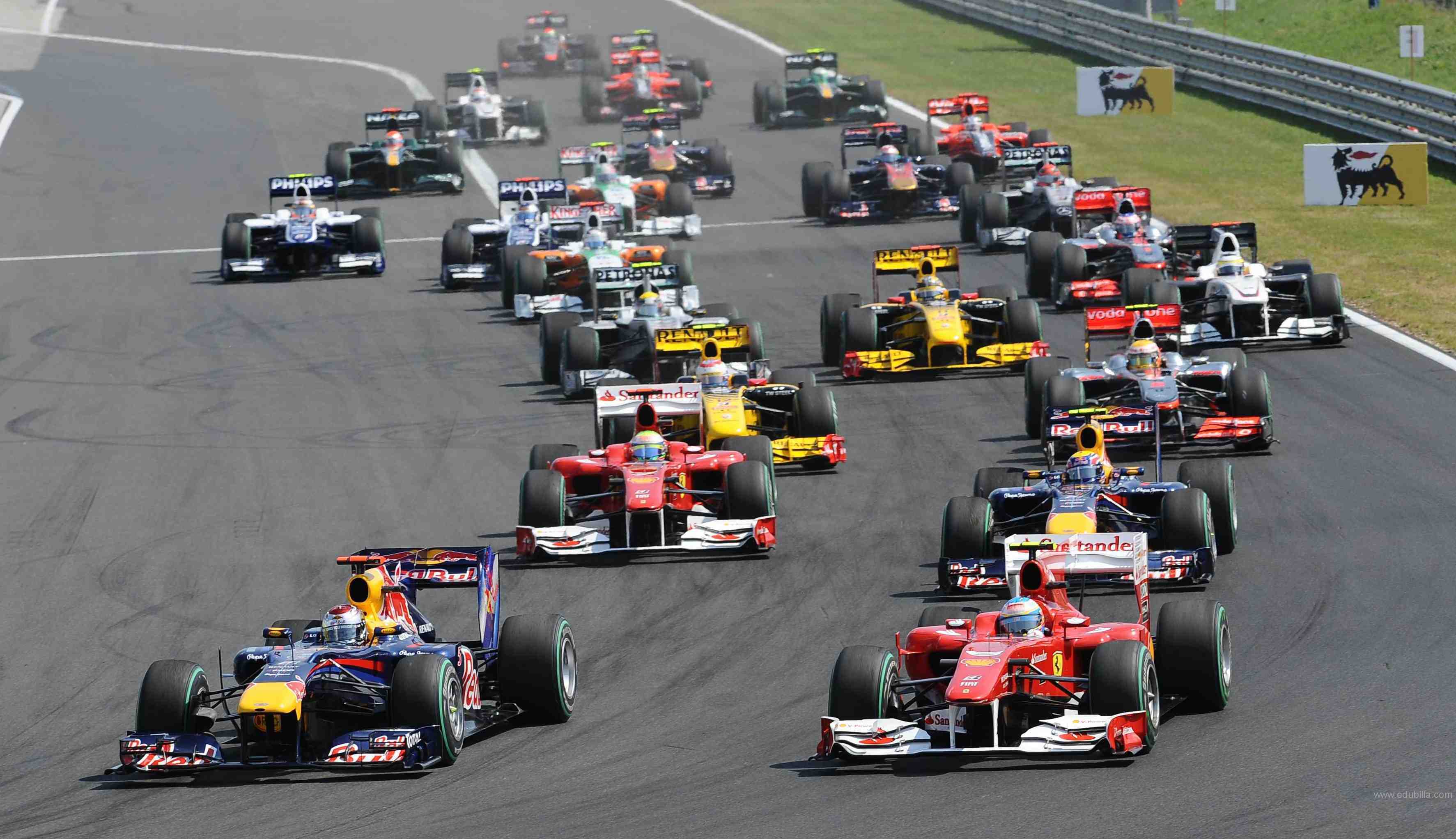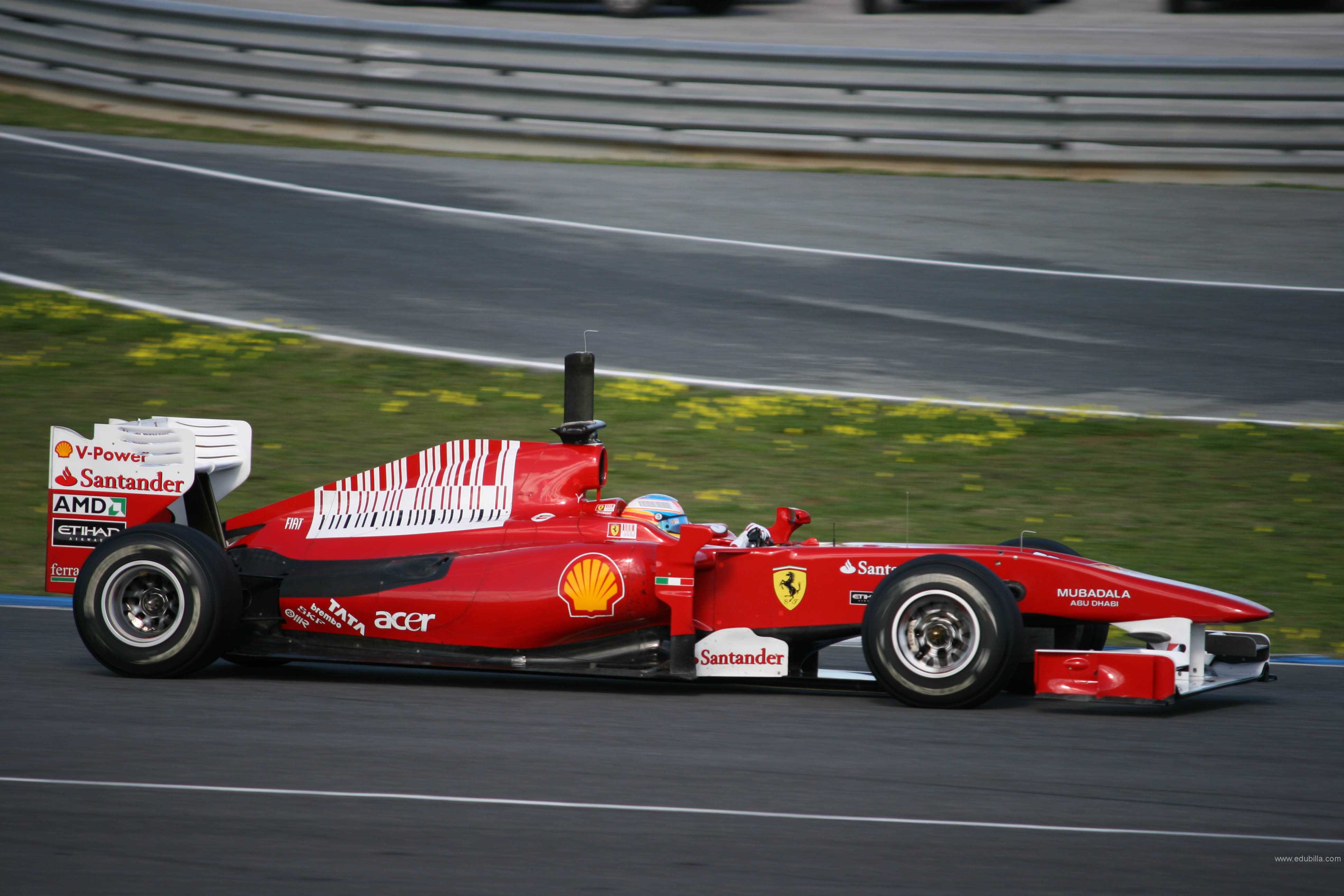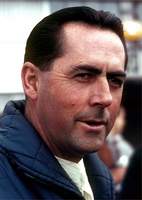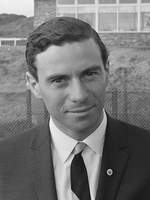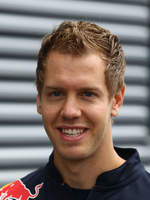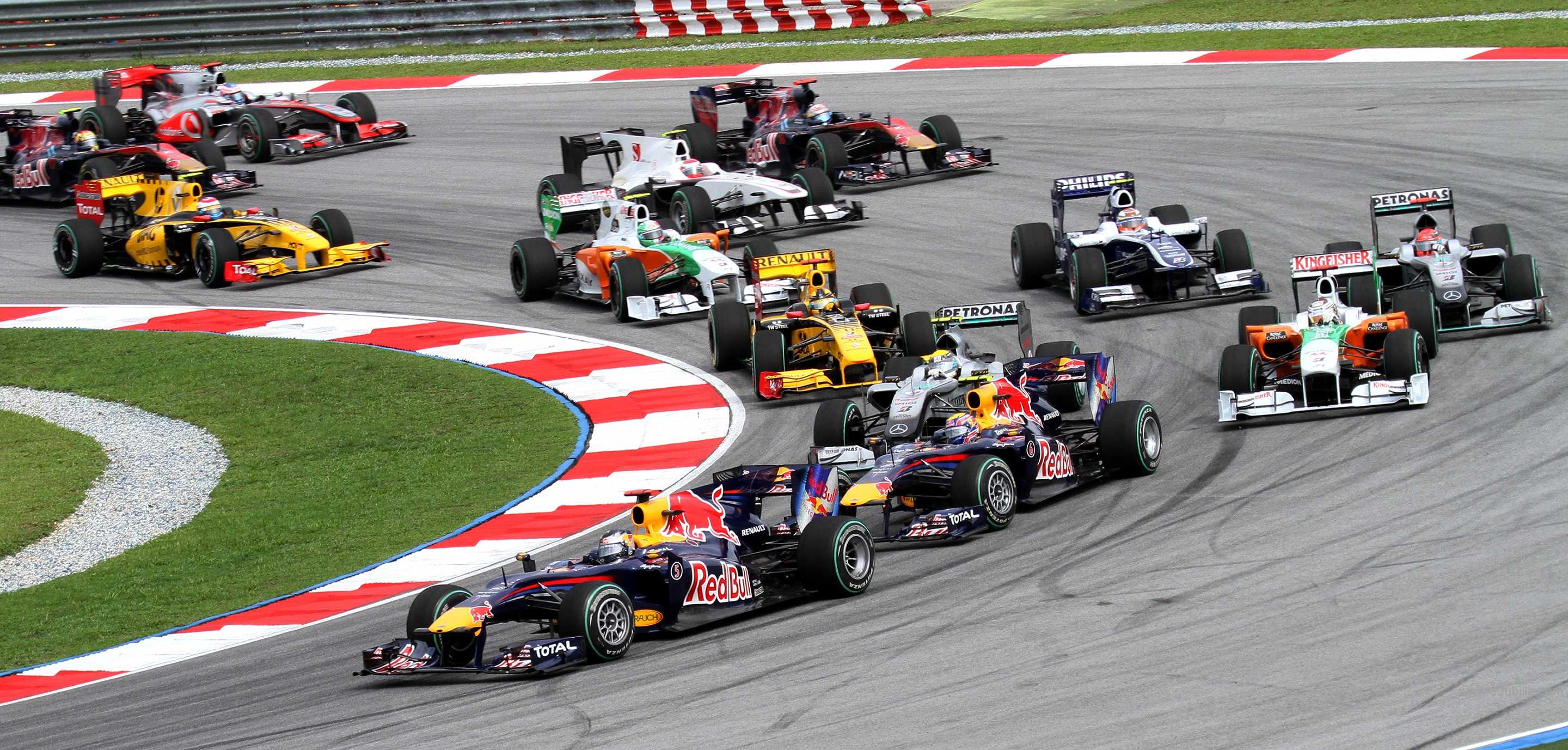
Overview Of Formula One
The FIA Formula One World Championship (also Formula One, or F1) is the highest class of single-seat auto racing that is sanctioned by the Fédération Internationale de l'Automobile (FIA).The "formula", designated in the name, refers to a set of rules with which all participants' cars must comply. The F1 season consists of a series of races, known as Grands Prix (from French, originally meaning great prizes), held throughout the world on purpose-built circuits and public roads. The results of each race are evaluated using a points system to determine two annual World Championships, one for the drivers and one for the constructors. The racing drivers, constructor teams, track officials, organisers, and circuits are required to be holders of valid Super Licences, the highest class of racing licence issued by the FIA.
Formula One cars are the fastest road course racing cars in the world, owing to very high cornering speeds achieved through the generation of large amounts of aerodynamic downforce. Formula One cars race at speeds of up to 360 km/h (220 mph) with engines currently limited in performance to a maximum of 15,000 RPM. The cars are capable of lateral acceleration in excess of five g in corners. The performance of the cars is very dependent on electronics – although traction control and other driving aids have been banned since 2008 – and on aerodynamics, suspension and tyres. The formula has radically evolved and changed through the history of the sport.
While Europe is the sport's traditional base, and hosts about half of each year's races, the sport's scope has expanded significantly and an increasing number of Grands Prix are held on other continents. F1 had a total global television audience of 425 million people during the course of the 2014 season.
Grand Prix racing began in 1906 and became the most popular type internationally in the second half of the twentieth century. The Formula One Group is the legal holder of the commercial rights. With the cost of designing and building mid-tier cars being of the order of $120 million, Formula One's economic effect and creation of jobs is significant, and its financial and political battles are widely reported. Its high profile and popularity have created a major merchandising environment, which has resulted in great investments from sponsors and budgets in the hundreds of millions for the constructors. Since 2000 the sport's spiraling expenditures have forced several teams, including manufacturers' works teams, into bankruptcy. Others have been bought out by companies wanting to establish a presence within the sport, which strictly limits the number of participant teams.
Game Rules
Technical
Engines: Now referred to as part of overall power units, engines must be turbocharged 1.6 litre V6s with a maximum RPM of 15,000 and the whole power unit must weigh a minimum of 145kg. Each car is allowed five power units (including the engine, motor generator unit-kinetic (MGU-K), the motor generator unit-heat (MGU-H), the energy store, turbocharger and control electronics) to be used as they see fit for the season. Five of each component are allowed to be used in any combination.
Should they need a further component they will have to contend with one of a number of penalties. A complete new power unit requires a driver to start from the pit lane, while using a sixth element will lead demotion of ten places from their qualifying position at the next race. If a different element requires a sixth (i.e it is not the first component to require a sixth) then a five-place grid penalty will be imposed, but the first time a seventh of any element is required then it's another ten-place penalty. Each subsequent seventh used will again lead to a five-place penalty, and so on.
Gearbox: Each driver must use the same gearbox for six consecutive events (Saturday and Sunday at race weekends). Should they need an additional box they will be hit with a five-place grid penalty.
ERS: While Kinetic Energy Recovery Systems were reintroduced in 2011 after the teams mutually agreed to suspend their use in 2010, 2014 sees the technology become known just as Energy Recovery Systems which is comprised of two main components known as the MGU-K and the MGU-H. In short, the MGU-K takes wasted energy under braking and turns it into additional power which is then stored and made available (in fixed quantities per lap) by means of a boost button controlled by the driver. The MGU-H recovers heat for a similar purpose.
Drag Reduction System: Moveable bodywork regulations introduced in 2011 allow adjustment of the rear wing from the cockpit to aid overtaking. The rear wing flap can only be opened at pre-determined points on the track during practice and qualifying and during a race only when a driver is less than one second behind another car in those zones. Braking deactivates the device. The intention is to decrease drag for the chasing car and improve the chances of overtaking. The only time it cannot be used under any circumstances is two laps after the start (or a safety car restart), under yellow flags and in wet conditions.
Weight: The weight of car and driver must be no less than 690kg at any point during a grand prix weekend. Teams try to build the car as light as possible and then use ballast in strategic areas to ensure they meet the weight requirements. The minimum weight may be increased or decreased to allow for any difference in weight of Pirelli's 2014 tyres compared to the 2013 ones.
Sporting
Race length: Races are run over the least number of complete laps which exceed a distance of 305km (although in Monaco this distance is lowered to 260km) and as all circuits are different lengths so are the number of laps the race is run over. In addition to the number of laps there is also a maximum time limit of two hours for a race.
Tyres: Teams are supplied by Pirelli with two different dry-weather compounds for each event. They also receive intermediate tyres and full wet tyres. In dry conditions, both compounds must be used on race day, meaning drivers have to pit at least once to change tyres. Each driver has a maximum of 12 sets of dry-weather tyres for each event, although this amount can be increased by the FIA to allow teams an extra set of prime, option or development tyres for Friday practice.
Teams can run one set of primes during the first 30 minutes of first practice and have to return that set as well as one other set of primes after the opening session plus a set of primes and a set of options after second and third practice, leaving them with six sets of dry tyres for qualifying and the race. To make it easier to spot which compounds are being used, the writing on the tyres are marked in different colours. Hard tyres have orange writing, mediums have white, softs have yellow, super-softs have red, intermediates have green and full wets have blue.
Qualifying: This is run over an hour and is split into three sessions. In Q1 (the first session) all cars may take to the track and complete as many or as few laps as they like. If any car fails to register a time within 107% of the fastest time in Q1 it will not be eligible for the grand prix, although may be allowed in if it has proven to be quicker in an earlier practice session. At the end of the 20-minute session there is a seven-minute break and the slowest six cars are eliminated and the times re-set. Q2 is run to the same rules over 15 minutes, and at the end of the session a further six cars are eliminated. This leaves the last 10 cars to fight it out in Q3 for the top ten grid spots in a session that lasts ten minutes.
Drivers: No driver can compete in a grand prix if they do not take part in Saturday practice. Each team may field up to four drivers over the season.
Points: Apart from at the final round, points are awarded to the top ten finishers as follows:
1st= 25 : 2nd = 18 : 3rd = 15 : 4th = 12 : 5th = 10 : 6th = 8 : 7th= 6 : 8th= 4 : 9th = 2 : 10th= 1
At the final round of the 2014 season, double points will be awarded:
1st= 50 : 2nd = 36 : 3rd = 30 : 4th = 24 : 5th = 20 : 6th = 16 : 7th= 12 : 8th= 8 : 9th = 4 : 10th= 2
If a race has to be stopped before 75% of the distance has been completed half points are awarded. Drivers score points for themselves and also for their team, if both drivers from a team finish in the points both scores count towards the constructors' tally.
Penalties: Blocking a rival driver, causing a crash, speeding in the pit lane or jumping the start can land a driver with a penalty. The penalties are handed out by the race officials known as stewards, who can dole out seven types.
The most popular is a drive-through penalty - where the driver is required to pass through the pit lane at the speed limit without stopping. If the stewards give a drive-through penalty and there is less than three laps of the race remaining, a 20-second penalty will be added to their race time.
More time consuming is a ten-second penalty, sometimes known as a stop-go - the drivers are required to stop in their pit box for ten seconds, during this time no work can be done on the car. Again, if there are less than three laps of the race remaining then a 30-second penalty will be added to their race time in this case.
The third is a time penalty, which can be added to a driver's race time after the chequered flag, often dropping him down the order.
Fourth is a basic reprimand. Three reprimands in the same season lead to a ten-place grid penalty, provided two of the reprimands were for driving infringements.
Fifth is a grid-position penalty for the next race - these are normally given post-race following investigations into dangerous driving. Teams can protest against these penalties.
The sixth and seventh are the most serious and can exclude a driver from the results or suspend them from future grands prix.
Furthermore, from 2014 stewards can impose penalty points on a driver's Super Licence for any of the above infringements. If a driver accrues 12 penalty points his licence is suspended for the next event (effectively he is banned for one race). Points remain on the Super Licence for 12 months.
Safety Car: As its name suggests, the safety car is deployed to ensure safe passage of the racing cars around the track. It is deployed after an accident that would otherwise cause the race to be stopped, but the use of the car allows the race to continue while the problem is dealt with. Laps under the safety car still count towards race distance. When it is time for the safety car to leave the circuit, it will turn off its yellow lights - racing then resumes when the leader crosses the safety car line (ahead of the start-finish line). In exceptional circumstances, such as heavy rain, a race may be started behind the safety car.
Equipments Need For Formula One
Safety equipment:
All cars must be fitted with a fire extinguishing system that will discharge into the cockpit and engine compartment. It must be operable by the driver and must function even if the car’s main electrical circuit fails.
There must also be a switch to trigger the system from outside the cockpit. Its location on the bodywork is indicated by a red letter “E” inside a white circle.
There must be a circuit breaker switch in the cockpit that the driver can use to cut all the car’s main electrical circuits. This is marked on the dashboard by a red spark in a white-edged blue triangle. There must be an additional switch that marshals can operate from a distance with the use of a special hook. This switch is located at the base of the car’s main roll-over structure.
All cars must have two rear-view mirrors, whose size and location must comply with strict requirements. Drivers must demonstrate to the FIA the effectiveness of the mirrors by identifying special letter and number boards placed at various distances behind the car whilst seated in the cockpit.
Seatbelts are compulsory in Formula One racing. Drivers must wear two shoulder straps, one abdominal strap and two straps between the legs. These must comply with strictly specified FIA standards.
All cars must have a red light on the rear of the car in a specific location defined by the FIA regulations. The driver must be able to switch this light on at any time. This is usually done in poor weather conditions in order to make the car more visible to following drivers.
The cockpit of the car must be padded to protect the driver in the event of an impact. In particular, the areas immediately behind and to the sides of his head, and above and to the sides of his legs.
In order to easily extract a driver from a car in the event of an accident its seat must be removable with the driver in place and his seatbelts fastened. The seat must be secured by no more than two bolts, which can be released using a standard tool issued to all rescue crews.
Driver equipment:
Because of the high speeds that are achieved in Formula One thanks to the technical evolutions during the year, drivers have to be well equipped to handle the cars, and to be able to endure this during 2 hours. We should not forget that no driver can do his job without any mistake, which is why the passive and active safety of the cars need to be of an extreme quality. Very much crashes (especially during the last 4 years) prove that the new constructed vehicles are safer and safer. It is to ensure this safety that many products were developed and enhanced during the history of motorsports.
Seat belts
That is certainly the first option to create a safe position for the driver. The 5-point star seatbelts keep the driver at his place all the time. They protect him from being swung out of the car when it rolls over or flies into a barrier.
Overall and fire protective suits
Fire protective balaclavaOne of the most important aspects to guarantee driver and equipment safety is to protect them from fire. Costs nor effort are saved to optimize that. The colourful suits that drivers wear are made of lightweight Nomex fibres. These stand 8 seconds of fire exposure, and thereby only causing minor injuries to the driver. The overalls are stitched in a very special way, which allows air cushions between the stitches. As air does guide warmth far less easy than solid material does, this is one of the most important features of an overall. Besides the overall, drivers are protected with a thin Nomex hose, all over their body. It consists of fire protective underwear, pants, a balaclava (image on the left), ... . They also wear Nomex shoes with a hard sole, that gives grip on the pedals, Nomex gloves with suede on the inside for comfort and extra grip on the steering wheel.
Helmet
F1 helmet design (Fernando Alonso)The helmet is the only protection for the driver's head. While it is recognition possibility for the spectators and commentators at the circuit, a helmet is the most important part in driver's safety, and even plays an important role in the car's aerodynamics. The helmet area is one of the most turbulent of an F1 car, and it is the aim of helmet designers like Schubert and Bell to decrease that unwanted side-effect. More importantly, when a helmet can be constructed in such a way that it guides more air into the airbox above the driver's head, it may increase engine power, and thus overall speed. Helmet designers should not forget to incorporate breathing holes, helmet ventilation possibilities, space and opening to allow a straw reach the driver's mouth for drinking during the race, and much more...
The helmet of each single F1 driver is custom made to fit the driver's needs. After all, the fit decides not only the comfort, but also the level of protection provided. While a common motorcycle helmet is constructed in three layers - padding, inside and outside shell - a Formula 1 helmet has no fewer than 17 layers. The individual components are a jealously guarded secret - the specialists cannot be persuaded to disclose more than the three main substances: carbon fibre for rigidity, fireproof aramide and polyethylene, which is also used in the production of bullet-proof vests and is intended to make the helmet impenetrable. Added to these are aluminium, magnesium and, as a binding agent, epoxy resin. In Formula 1, the saying goes "what is good for a monocoque also makes good clothing". The carbon fibre compounds (CFC) used mean that the helmets are extremely lightweight at about 1.25kg, but can also withstand considerable punishment. The advantages of a light helmet are clear - it serves to reduce the strain on the driver's neck muscles, especially in track sections with high G forces.
During the production of a helmet, 120 carbon fibre mats are glued together. After that, the helmet is off into the autoclave, where the individual layers are bonded to one another and hardened under high pressure and at a constant temperature of 132°C. Parts subject to exceptional loads, such as the underside and the visor cut-out, are additionally reinforced using aluminium and titanium. The interior padding consists of two layers of fireproof Nomex. The ventilation system is designed to allow up to five litres of fresh air to flow into the helmet's interior. A filter cleans the air of the finest motor oil, carbon and brake dust particles. A radio in the chin area provides the means for communication with the pit. Thanks to a tremendous research and development effort, the noise level inside the helmets has been reduced to below 100 decibels.
A good view even in the most difficult situations is vital for the drivers. This is provided by the helmet's 3mm thick visor. It is made from fireproof polycarbonate and its inside is extremely easy on the eye. The tinting adjusts within fractions of a second - similar to some sunglasses, only much faster. For instance, at the tunnel entrance in Monaco, the visor brightens up, darkening again in a split second at the tunnel exit, so that the drivers are not blinded. The visor is furthermore heated to prevent Despite Formula 1 taking a break over winter, the visor is heated.
Before the Fédération Internationale de l'Automobile (FIA) grants its approval for a helmet, it has to pass a number of different crash tests. During the so-called 'penetration test' a 3kg, pointed metal object is dropped from a height of three metres onto the helmet, which must remain unruptured. The helmet's secure fit is also tested. Subjected to a load of 38kg, the chin strap may not stretch by more than 30mm. The visor is bombarded with projectiles travelling at approximately 500km/h. The points of impact may be no deeper than 2.5mm. Last but not least, the helmet is subjected to an 800°C flame for 45 seconds in the fire test. During this time, temperatures inside the helmet may not exceed 70°C.
However, when performance does matter, the driver's comfort should be taken very seriously. As the driver's head is close to the engine, a lot of noise comes with driving a Formula One car. Some helmet design factors try to resolve such things to increase the driver's comfort, and make him able to concentrate better. The following illustration shows all important parts of what may become a standard F1 helmet (this helmet is not yet used by any driver in Formula 1 yet, but has been designed by Schubert for Michael Schumacher). The mouthpiece is similar to that of a fighter pilot and will enable Schumacher to breathe as the helmet will be sealed in order to muffle the noise.:
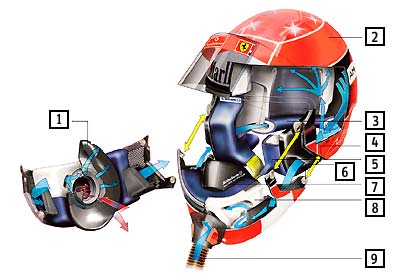
Head and Neck Support (HANS) system:
Drivers face theoretical deceleration stresses of up to 80 times the force of gravity in an accident. In such a situation, the weight of their head and helmet increases quickly from 7kg to as much as 560kg. HANS would help to absorb this strain, as well as prevent the driver's head from hitting the steering wheel or the front edge of the cockpit. The idea for a neck brace first came about in 1995 following Mika Hakkinen's accident in Adelaide when the Finn's head hit the steering wheel after his car lost control following a tyre deflation and hit the tyre barrier at brewery bend at high speed.
The system was designed at the University of Michigan. Commissioned by the FIA and in co-operation with its inventor Dr. Robert Hubbard, Mercedes-Benz further developed the 1996 version of the head and neck support. In practice, HANS has initially proven successful in the US NASCAR, ChampCar racing series and in the German Touring Car Masters (DTM).
History Of Formula One
Formula One automobile racing has its roots in the European Grand Prix championships of the 1920s and 1930s. The foundation of Formula One began in 1946 with the Fédération Internationale de l'Automobile's (FIA's) standardisation of rules. A World Drivers' Championship followed in 1950. The sport's history parallels the evolution of its technical regulations.
In addition to the world championship series non-championship Formula One races were held for many years, the last held in 1983 due to the rising cost of competition. National championships existed in South Africa and the UK in the 1960s and 1970s.
1950s: No thought given to safety
1950–1953
Engine specs set at 1500 cc maximum size for engines with a compressor (supercharger or turbocharger) or 4500 cc for normally aspirated engines. No weight limit.Note that in 1952 and 1953, the World Drivers' Championship was run to Formula Two regulations (maximum capacity of 750 cc for engines with a compressor or 2000 cc for normally aspirated engines), but the Formula One regulations remained unchanged, and numerous non-championship Formula One races were held during this period. Also for 1952, crash-helmets were made compulsory; but these helmets were made with dubious materials and looked like medium-sized dinner bowls.
1954
Engine specs amended to allow 750 cc maximum engine size with a compressor or 2500 cc for a normally aspirated engine. No weight limit.
1958
The use of commercial petrol became compulsory and alcohol-based racing fuels were no longer permitted.
1960s: Safety as an afterthought
The swinging sixties began the way the previous decade had ended for Formula One's rule book with relatively few changes made. However with the advent of a new breed of innovative and forward thinking designers like Colin Chapman and the beginnings of drivers lobbying for safer racing conditions,the number of rule changes made began to accelerate as the decade came to a close.
1960
Regulations unchanged from 1959 (maximum engine capacity of 750 cc for a compressed engine or 2500 cc for normally aspirated engines. No weight restrictions).
1961–1965
Engine specs amended to a normally aspirated engine of between 1300 cc and 1500 cc, no compressors allowed, minimum weight set at 450 kg, pump fuel only, automatic starter, roll bar required, double braking system mandatory, standardised seatbelt anchorage, fire protection for fuel tanks, fillers and breathers, FIA begin to organise safety inspections (previously done by local authorities), protective helmet and overalls obligatory, flag signalling code established.
1966–1969
Engine specs amended to a 1500 cc engine with a compressor or a 3000 cc normally aspirated engine allowed, minimum weight set at 500 kg, electrical circuit breaker, reverse gear, oil catch tank, a rollbar 5 cm above driver's head, two-part extinguisher system and cockpit designed for quick evacuation all made mandatory, all aerodynamic features must be immobile (thereby banning air brakes) and fixed to a sprung part of the car, maximum bodywork height and width restrictions ban the use of dangerous high wings, recommendations made on seat harnesses, fire resistant clothing and shatter-proof visors.
1970s: The beginnings of modern Formula One
1970
Engine specs amended to 1500 cc compressed engine or 3000 cc normally aspirated engine, minimum weight set at 530 kg, safety bladder fuel cell tanks introduced, report published on track standards, recommended straw bales be banned, double guard rails in place, 3 metre grass verges, spectators to be kept a minimum of 3 metres behind guard railings, barrier between pit lane and track as well as track width, surface and gradient recommendations and mandatory FIA inspections of track facilities.
1971
Role responsibilities and mandatory equipment list set out for race supervisors, marshals and signalers, drivers must be evacuated from cockpit in less than five seconds. All race distances must be under 200 miles (320 km).
1972
Maximum permitted size of a compressed engine increased to 1500 cc, minimum weight increased to 550 kg, safety foam in fuel tanks, no magnesium sheeting to be less than 3 mm thick, 15w red rear light mandatory, head rest required, minimum cockpit dimensions, combined electrical cut off and extinguisher external handle required, fuel tanks to meet FIA specifications, six point harness required, circuit safety criteria set down, driver's code of conduct released.
1973
Numbers now assigned to drivers. The #1 number is assigned to the reigning World Champion. Minimum weight increased to 575 kg, crushable structure around fuel tanks mandatory, no chrome plating of suspension parts allowed (to avoid hydrogen embrittlement), drivers required to carry medical card and submit to medical examination before they are able to race, catch fencing and rescue equipment mandatory at races, starting grid dimensions standardised, fire service regulations established.
1974
Self-sealing fuel lines mandatory, sand traps added to catch fencing as safety features at circuits, 2x2 staggered starting grid with 12 metres allowed per car.
1975
Marshal's posts to be provided with service roads for ease of access, FIA standard set for fire resistant clothing.
1976
Airboxes on the top of cars are banned, and the cooling of engines through similar means is heavily limited. "Safety structures" around dashboard and pedals implemented. After Niki Lauda's near-fatal accident at a nearly inaccessible point at the treacherous 14.2 mi (22.8 km) Nürburgring in West Germany, the circuit was taken off the 1977 calendar after having been on the calendar for all but 4 seasons of Formula One up to 1976.
1977
Pedal box safety structures more adequately defined, gravel traps defined more adequately, helmets must be made to FIA approved standards.
1978
Brabham's BT46B 'fan car' deemed illegal and banned after its first (and only) appearance of the season where it won at the Swedish Grand Prix, bulkhead behind driver and front roll bar defined, licence qualification criteria set for all drivers, all grid slots allocated 14 metres per car.
1979
Medical air required to be piped into drivers helmet in the event of an accident, bigger cockpit opening, two mirrors and better fire extinguisher on board cars required, FIA appointed, professional, permanent race starter mandatory.
1980s: Formula One becomes a business, taming the turbos and other technologies
1980
Permanent medical facility required at all tracks, these facilities must be staffed by FIA approved medics, fast response car mandatory at all races, minimum weight for F1 car set at 575 kg.
1981
The new Formula One World Championship is officially established by Formula One Management, an organization headed by Britons Bernie Ecclestone and Max Mosley. Through the teams' and the FIA's signing of the 1st Concorde Agreement concocted by Ecclestone and Mosley, they officially set newly organized standards, such as no more sequences of races being run over a period of seven months, and practice and qualifying sessions and the races being started at official times. The series is now an official business operating by its own operational standards while adhering to regulations set by the FIA; all of the circuit organizers must comply to these standards and regulations. This includes private entries of other makes of car disallowed. Any team entering any official championship Formula One race must enter their own cars and all teams have to commit to the number of races scheduled each season. Although the teams have to make their own cars, they are still allowed to purchase engines and gearboxes from independent manufacturers. Flexible side skirts banned to reduce downforce created by ground effect, mandatory ground clearance of 6 cm required to limit ground effect further, Lotus twin chassis type 88 outlawed, pit lane minimum width set at 10 metres, survival cell extending to the front of the drivers feet introduced to improve driver survivability in the event of an accident, minimum weight of car set at 585 kg.
1982
Rotary engines, diesel engines, gas turbine engines and sarich orbital engines all banned as part of the Concorde Agreement, rigid skirts legalised and ride height restrictions removed as FIA admit that policing a ban is not possible whilst many teams are using hydraulic suspension systems to alter ride heights and circumvent the rules, minimum weight of car set at 580 kg.
1983
Ground effect outlawed completely for the beginning of the 1983 season. all cars return to a flat undertray, four wheel drive banned along with cars with more than four wheels,minimum weight set at 540 kg.
1984
In race refuelling outlawed, fuel tank required to be in centre of car, between driver and engine, maximum fuel capacity allowed on cars set at 220 litres per race to try and reduce the output of turbo engines, drivers required to have FIA super licence before they can compete in F1, concrete retaining walls permitted alongside guard rails.
1985
Rear-wing size limits set in place. All cars now subject to a frontal crash test to be deemed race worthy.
1986
Catch-fencing banned, permanent FIA medical service inspector and medevac helicopter mandatory at race meetings, after needless death of Elio de Angelis in testing. All F1 test sessions to be completed under full race meeting safety conditions, engine capacity 1500 cc with compressor (i.e. normally aspirated engines prohibited), maximum fuel consumption reduced to 195 litres per race.
1987
Boost pressure capped at 4.0 bars to limit turbo power, minimum weight of cars set at 500 kg. Normally aspirated engines are permitted again, with a maximum capacity of 3500 cc and no fuel limit. Grid slots allocated 16 metres per car.FIA announce that from 1989 onwards turbos will be banned and to encourage teams to switch, two additional championships are introduced, which are open to non turbo teams only: the Jim Clark Cup for drivers, and the Colin Chapman Trophy for constructors. These one-off championships are won by Jonathan Palmer and by Tyrrell-Ford respectively.
1988
Boost pressure further reduced to a maximum of 2.5 bars to limit the power output of the turbo engines in their final year, maximum fuel consumption of turbo cars reduced to 150 litres per race. In any design the drivers feet must not extend beyond the front wheel axle, static crash test of survival cell and fuel cell mandatory, minimum weight of cars increased to 540 kg.
1989
Turbocharged engines banned completely, normally aspirated engines of 3500 cc in size and 8 to 12 cylinders the only engines permitted, fuel restrictions removed, all track side guard rails must be a minimum of 1 metre in height and the pit wall must be a minimum of 1 m 35 cm in height, all drivers subject to anti doping testing as per IOC guidelines.
1990s: Complacency proves costly
1990
Large mirrors and quick release steering wheel made mandatory, all marshals and medical staff must practice driver extrication exercises.
1991
Front wing narrowed from 150 cm (59 in) to 140 cm (55 in). Rear overhang reduced from 60 cm (24 in) to 50 cm (20 in). More stringent testing of survival cell by FIA including seat belts, fuel tanks and rollbar. Points scoring system overhauled, win now secures 10 points and all results to count instead of best 11 scores.
1992
Yet more exhaustive testing of survival cell including rear impact testing, height of kerbing lowered, minimum width of pit lane increased to 12 m (39 ft), pit lane entry chicane mandatory, safety car introduced.
1993
Rear tyre width reduced from 18 inches to 15 inches to reduce the grip and so the speed of the cars, overall car width reduced to 200 cm. Rear wing height reduced from 100 cm to 90 cm, distance of front end plates from flat bottom increased from 25 to 40 mm (0.98 to 1.57 in),head rest area increased from 80 to 400 cm2 (12 to 62 in2). Continuously variable transmission (CVT) banned before ever appearing at a race.End of race crowd control measures implemented, 50 km/h speed lane restriction during free practice. Fuel used restricted to that available to the general public.
1994
Ban on electronic driver aids such as active suspension, traction control,launch control, ABS, and (without ever appearing in a race) 4 wheel steering at the beginning of the season, mid race refueling allowed for the first time since 1983, post Imola sweeping changes introduced to slow cars down, starting from the Monaco race onwards, a pit lane speed limit is put in place; between the Spanish Grand Prix and the German Grand Prix, additional changes are phased in and include a reduction in the height of the rear wing of 10 cm, an increase in the height of the front wing, no front wing trailing assemblies to extend behind front wheel, a 10 mm wooden plank fitted to the under tray (permitted to be worn by no more than 1 mm by the race end), a ban on high rear wing assemblies extending ahead of the rear axle line to sidestep the wing height restrictions, depressurising the engine airbox to reduce power, minimum headrest thickness 75 mm (3.0 in) introduced, more stringent fire extinguisher regulations and driver helmet criteria implemented, a pit lane speed restriction of 80 km/h (50 mph) in practice and 120 km/h (75 mph) in race conditions introduced, also the parade lap was to be completed behind safety car (abandoned from Imola onwards), pit spectator area to be fire shielded, 27 corners identified as very high risk and as a result changes to circuit layouts implemented to remove or modify these parts of the track. After Imola, pit lane speed limit is implemented.
1995
A reduction in engine capacity from 3,500 to 3,000 cc (214 to 183 cu in) to further slow cars, longer cockpit openings to reduce chance of drivers head hitting it in the event of an accident, survival cell side impact tests introduced, obligatory automatic neutral selection when engine stops, increase in length chassis must extend beyond drivers feet from 15 to 30 cm (5.9 to 11.8 in), frontal impact test speed increased from 11 m/s to 12 m/s, kerbs made smoother, pit wall debris shield installed, 3 inch safety straps mandatory, super licence criteria and fuel restrictions made more stringent (i.e. special racing fuels - previously an exotic mixture of benzenes and toluenes, are banned; only those with similar characteristics to everyday unleaded petrol are permitted).
1996
Increased cockpit protection around the driver's head. Front wing end plates to be no more than 10 mm thick to reduce damage to tyres of another car in the event of collision, all harness release levers must point downwards, to qualify for a race all cars must now be within 107% of pole time, car numbers now allocated on the basis of previous seasons performance, Friday qualifying abandoned but number of free practice sessions increased from two to three and number of laps allocated each day increased from 23 to 30, standardisation of all FIA safety cars and medical cars, more fire drills for marshals, starting procedure improved, data storage unit to be mounted within survival cell.
1997
Test tracks now require FIA approval and supervision, kerbing standardised, bolted tyre wall construction obligatory, cars to carry FIA ADR (accident data recorder) to analyse success of implemented safety measures, FIA approval required for all chief medical officers and medical centres, safety car made more powerful and may now be used for wet weather starts, accident intervention plan revised.
1998
Narrow track era begins in Formula One, width of car reduced from 2 metres to 1.8 metres with teams now running rubber with grooves in (4 on the rear and 3 on the front) to reduce the speed of the cars, asymmetric braking banned, X-wings banned, single fuel bladder mandatory, refueling connector must be covered, cockpit dimensions increased, side impact test now to use 100% more energy, tyre barrier effectiveness increased, pit lane must now have 100 m of straight running before first pit garage, increased use of pit lane lights alongside flags.
1999
Number of grooves on front tyres increased from three to four, flexible wings banned,pit lane shielding standardised, some run off areas to have asphalt instead of sand traps, at least four medical intervention cars and an FIA doctor car required, ADR required to be in operation during testing, wheels must be tethered to car to reduce the risk of launched components during an accident, rear and lateral headrest assembly made one piece and quick release, engine oil breathers must vent into engine air intake, extractable driver's seat madatory, frontal impact test speed increased to 13 m/s.
2000 to 2010: Excess gives way to sustainability
2000
Engines other than V10, normally aspirated, larger than 3000cc, are banned. No additional regulation changes.
2001
Traction control allowed again as FIA admit they are unable to police whether teams are using the system effectively, use of beryllium alloys in chassis or engine construction banned. Larger cockpit entry template and survival cell. Rear wings must have no more than 3 elements.
2002
Team orders banned after Rubens Barrichello hands victory to Michael Schumacher at final corner of the Austrian Grand Prix.
2003
Bi directional telemetry banned HANS (head and neck safety) system mandatory, change to point scoring system, points now being awarded down to 8th place, actual points scored now to run 10,8,6,5,4,3,2,1 from 1st to 8th place, testing allowed on a Friday of a race meeting in exchange for a reduction of testing mileage allowed outside of the Grand Prix calendar to make it more affordable for smaller teams, changes to qualifying session with only one flying lap now allowed for grid position with the 107% rule no longer applied, cars may not be refueled between final qualifying and the race start.
2004
Engines required to last a whole race meeting, any engine change to result in 10 place grid penalty, minimum weight set at 605 kg during qualifying and at no less than 600 kg at all other times (including driver and fuel), pit lane speed limited to 100 km/h at all times, each driver must select his wet and dry weather tyre compounds before the start of the race, minimum size of engine cover and rear wing end plates set to maximise advertising space, multi element rear wings banned and two element wings mandated, launch control banned for the second time, fully automatic transmission banned.
2005
Rear diffuser size reduced to limit downforce, all engines now required to last two race weekends, qualifying format changed to two aggregate times from Saturday afternoon and Sunday morning to count towards grid positions (this format lasted until the European GP when qualifying reverted to a driver's fastest single lap to count from Saturday afternoon qualifying), further changes to dimensions of front and rear wings and nose of car to make overtaking easier, restriction on tyre changes during qualifying and the race itself, if a driver stalls on the grid after the parade lap the other cars will now complete a second lap whilst the stalled vehicle is removed, in the event of a red flag the two-hour race clock will no longer freeze between race sessions.
2006
Only 14 sets of tyres allowed all weekend (seven dry, four wets and three extreme wets), in race tyre changing permitted again, qualifying format changed to three 15 minute shoot outs where the slowest cars are eliminated in the first two sessions leaving the 10 quickest to start with a clean slate and to go for pole position, the final session was reduced from 20 minutes to 15 minutes from the French Grand Prix onwards, Saturday free practice increased from 45 minutes to an hour in length.Engine capacity limited to 2400 cc and number of cylinders allowed reduced to eight in an attempt to reduce horsepower (although teams were allowed to run a rev restricted V10 for an interim period if no engine under the new regulations was available to them), restriction in the use of non ferrous materials in engine construction along with limiting the number of valves per cylinder to four, all engines must be of a 'V' configuration and at an angle of 90 degrees,
2007
Tuned mass damper system banned,rev limit of 19,000 rpm introduced, rear wing structure strengthened to prevent flexing, increased strength required from rear crash structure, single tyre supplier (Bridgestone) after withdrawal of Michelin, revised tyre regulations mean drivers must use both hard and soft compound tyre during the course of race (soft compound tyres are identified by a white stripe in one of the front tyre grooves), engine development frozen until the end of 2008 to cut costs, further restrictions to regulations means no teams may run a 3rd car on Friday, both sessions on Friday extended to 90 minutes in length, engine changes on first day of practice no longer subject to grid place penalty, pit lane restrictions during any period the safety car is on the track, annual testing limited to 30,000 km to reduce costs.
2008
Traction control banned for the second and final time by means of all teams using a standard electronic control unit (ECU) to eliminate the possibility of teams concealing the technology within their own engine management systems, strict limits placed on the amount of CFD and wind tunnel testing allowed each year.
2009
Banning of almost all aerodynamic devices other than front and rear wing, slick tyres allowed once more (keeping to narrow track dimensions), limit of eight race/qualifying engines for the whole season (every new engine above this eight results in 10-place grid penalty), reduction of rear wing width from 1000 mm to 750 mm and in increase in height from 800 mm to 950 mm, reduction in the ground clearance of front wing from 150 mm to 50 mm and an increase in width from 1400 mm to 1800 mm, rear diffuser to be longer and higher, variable front aerodynamic devices permitted (with limited in car control by driver) and the introduction of KERS (kinetic energy recovery system) to store some of the energy generated under braking and convert it into a temporary horsepower increase of around 80 bhp that can be used 6.6 seconds per lap by the drivers for overtaking.
2010
Drastic cost-cutting measures are introduced. In-race refueling ban returns, as a result fuel can be added to any F1 car after qualifying, but Q3 drivers must start the race with the tyres they set their fastest Q3 time with. The same 8 engine limit is maintained despite the increase to 19 races over the course of the season (with a rev limiter set at 18,000 rpm to assist in this), front tyre width reduced, a ban on testing during the season as well as an agreement with teams about reducing the number of staff employed. 3 new teams mean 7 drivers are now dropped from Q1 and Q2. Scoring system changed to allow the first ten cars to receive points: 25, 18, 15, 12, 10, 8, 6, 4, 2, 1. Backmarkers no longer able to unlap themselves behind the Safety Car. Teams unanimously agree not to use KERS for the 2010 season in order to allow all teams time to be able to develop and perfect their own systems.
2011 and beyond: "Improving the show"
2011
The double-diffuser concept is banned, with teams requiring the use of simple, single-piece diffusers. The "F-duct" system pioneered by McLaren is banned (in conjunction with banning shark fins from being connected to the rear wing). Adjustable front wings have also been banned. Gearboxes must last for 5 race weekends, but for the season each driver has one penalty free gearbox change at their disposal. Driver adjustable rear wing, known as DRS (drag reduction system) introduced to help overtaking. Can be freely used in practice and qualifying, but in the race only when within 1 second of the next car by the detection zone, and only activated in the activation zone.
2012
Exhaust tailpipes raised after dispute regarding off-blown diffuser at the 2011 British Grand Prix, car noses reprofiled.Reactive ride systems, "exotic" engine maps, and heliums at air guns (to change tires) banned. Cars must be cleared from all crash tests before pre-season testing. Races capped to four hours following long red flag of the 2011 Canadian Grand Prix.In-season testing allowed again at the circuit the FIA or teams (upon agreement) choose (Mugello Circuit in case of 2012).
2013
Further cost-cutting measures introduced, DRS restricted at the designated zones during free practice and qualifying, mid-season testing discontinued once more, "modesty panels" introduced to compensate for the previous year's front nose reprofilling, double-DRS (pioneered by Mercedes) banned, minimum weight increased to 642 kg (1,415 lb).
2014
New car formula of turbocharged V6 engines with 1600cc capacity and 8-speed gearbox introduced, which must now last at least 4,000 km (2,500 mi) before being replaced and have the KERS (now known as ERS-K) integrated into it. New penalty points system introduced, teams must nominate eight gear ratios ahead of the first race, false camera mountings banned, in-season testing returns, car nose further reprofiled. A new car number system where the driver is able to choose their own numbers for the duration of their career is also adopted.
2015
Restrictions on team radio communication enacted.
Origin Of Formula One
Formula One was first defined in 1946 by the Commission Sportive Internationale (CSI) of the FIA, forerunner of FISA, as the premier single seater racing category in worldwide motorsport to become effective in 1948. It was initially known variously as Formula A, Formula I or Formula 1 with the corresponding "Voiturette" formula being titled Formula B, Formula II or Formula 2. When the 500c formula was internationally recognised as Formula 3 in 1950 it was never titled as "Formula C" so the three International Formulae were "officially" titled Formula 1, Formula 2 and Formula 3.
First Race:
In the beginning, the formula was largely based on pre-World War II regulations defined by engine capacity. The regulation expected to bring a new balance between supercharged and normally aspirated cars. Non supercharged 4.5 litre pre-war Grand Prix cars were allowed to race against the pre-war 1.5 litre supercharged 'voiturettes' while pre-war supercharged 3 litre Grand Prix cars were banned. The first race under the new regulations was the 1946 Turin Grand Prix held on 1 September, the race being won by Achille Varzi in an Alfa Romeo 158 Alfetta.
Motorcycle World Championships:
The Motorcycle World Championships was introduced in 1949. In 1950 the Fédération Internationale de l'Automobile (FIA) responded with the first ever official World Championship for Drivers using the Formula One rules. The championship series, to be held across six of the 'major' Grands Prix of Europe plus the Indianapolis 500, was in effect a formalization of what had already been developing in Grand Prix racing during the previous years. Italian teams of Alfa Romeo, Ferrari, and Maserati were best positioned to dominate the early years. Other national manufacturers such as the French manufacturer Talbot or the British BRM competed, although less successfully. A number of private cars also took part in local races. The Italian and German factory teams in those days often employed 2 to 3 drivers whose nationality was the same as the team's and at least 1 foreign driver; for example the Alfa Romeo team in 1950 consisted of Italian drivers Giuseppe Farina, Luigi Fagioli and Piero Taruffi; and Argentine driver Juan Manuel Fangio.
Governing Bodies
International Automobile Federation:
The Fédération Internationale de l'Automobile (FIA, English: International Automobile Federation) is an association established as the Association Internationale des Automobile Clubs Reconnus (AIACR, English: International Association of Recognized Automobile Clubs) on 20 June 1904 to represent the interests of motoring organisations and motor car users. To the general public, the FIA is mostly known as the governing body for many auto racing events.
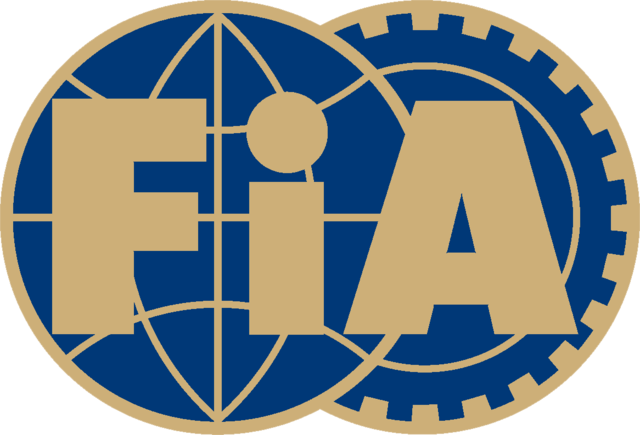
Headquartered at 8, Place de la Concorde, Paris, the FIA consists of 213 national member organisations in 125 countries worldwide.Its current president is Jean Todt.
The FIA is generally known by its French name or initials, even in non-French-speaking countries, but is occasionally rendered as International Automobile Federation.
Its most prominent role is in the licensing and arbitration of Formula One and World Rally Championship motor racing. The FIA along with the Fédération Internationale de Motocyclisme (FIM) also certify land speed record attempts. The International Olympic Committee provisionally recognized the federation in 2011, and granted full recognition in 2013.
History:
The FIA was founded on 20 June 1904 as the AIACR, an umbrella organization of national motor clubs. It became the FIA in 1947.
In 1922, the FIA delegated the organisation of automobile racing to the Commission Sportive Internationale (CSI), an autonomous committee that later became the Fédération Internationale du Sport Automobile (FISA). A restructuring of the FIA in 1993 led to the disappearance of FISA, putting motor racing under direct management of the FIA.
Presidents:
International Association of Recognised Automobile Clubs
-Etienne van Zuylen van Nijevelt 1904-1931
-Robert de Vogue 1931-1936
-Jehan de Rohan-Chabot 1936-1946
International Automobile Federation
Jehan de Rohan-Chabot 1946-1958
Hadelin de Liedekerke Beaufort 1958-1963
Filippo Caracciolo di Castagneto 1963-1965
Wilfred Andrews 1965–1971
Amaury de Merode 1971-1975
Paul Alfons von Metternich-Winneburg 1975-1985
Jean-Marie Crossbows 1985-1993
Max Mosley 1993–2009
Jean Todt 2009–present
Awards Related To Formula One
Autosport Awards:
The Autosport Awards are a series of awards given out by motor racing magazine Autosport to drivers that have impressed throughout the previous season. These awards are also influenced by the general public, as they can vote for the driver that has excelled to them throughout the year, before the awards are handed out every December. The awards have been handed out since 1982.
Categories:
There are twelve awards handed out by the magazine - eight of which are voted on, by the general public and four are chosen by the magazine and/or a handful of professionals who are there to judge a competition (McLaren Autosport BRDC Award). These are:
-McLaren Autosport BRDC Award
-International Racing Driver of the Year
-International Rally Driver of the Year
-Rookie of the Year
-Racing Car of the Year
-Rally Car of the Year
-British Competition Driver of the Year
-National Driver of the Year (combined for 2008: 1982-2007 saw an award for National -Racing Driver and National Rally Driver)
-British Club Driver of the Year
-John Bolster Award
-Gregor Grant Award
-Pioneering & Invention Award
McLaren Autosport BRDC Award:
The McLaren Autosport BRDC Award is an award set up in 1989 to reward and recognise young racing drivers from the UK. As its names suggest, the award is backed by Formula One team McLaren, motorsport magazine Autosport, and the British Racing Drivers' Club (BRDC). As well as the prestige of winning the award, a test drive in a McLaren Formula One car and £100,000 – increased from £50,000 in 2010 – cash prize, the award winner is also presented with the Chris Bristow Trophy.
Motorsports Hall of Fame of America:
The Motorsports Hall of Fame of America is a Hall of Fame and museum for American motorsports legends. It was originally located in Novi, Michigan and it moved to the Detroit Science Center in 2009.
The museum is in the process of moving to Daytona International Speedway which is anticipated to be completed by January 2016.
Sample Documents Of Formula One
-Andre Agassi





